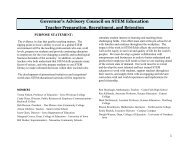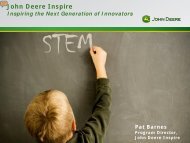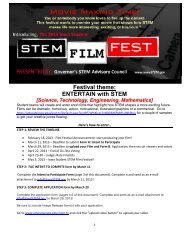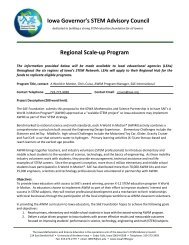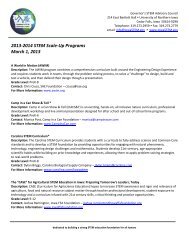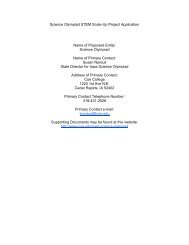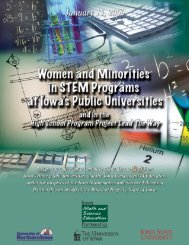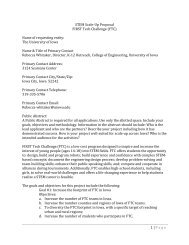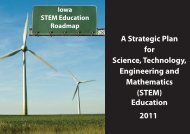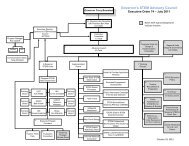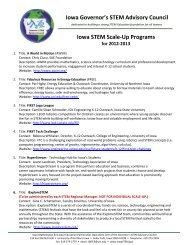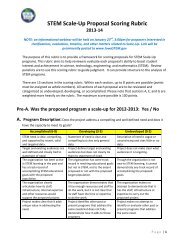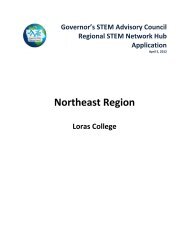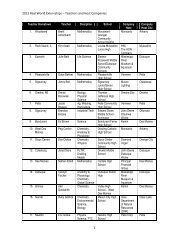Iowa Governor's STEM Advisory Council brochure
Iowa Governor's STEM Advisory Council brochure
Iowa Governor's STEM Advisory Council brochure
You also want an ePaper? Increase the reach of your titles
YUMPU automatically turns print PDFs into web optimized ePapers that Google loves.
IOWA’S <strong>STEM</strong> SOLUTION<br />
Governor Terry Branstad’s Executive Order 74 created the<br />
Governor’s <strong>STEM</strong> <strong>Advisory</strong> <strong>Council</strong> in the summer of 2011.<br />
The <strong>Council</strong>’s overarching goal is to boost student interest<br />
and achievement in science, technology, engineering and<br />
mathematics (<strong>STEM</strong>), so our young people have more career<br />
opportunities and our state’s economy is more robust.<br />
Co-chaired by Lieutenant Governor Kim Reynolds and University<br />
of Northern <strong>Iowa</strong> President Ben Allen (to be succeeded by<br />
Vermeer CEO Mary Vermeer Andringa in June 2013), the<br />
Governor’s <strong>STEM</strong> <strong>Advisory</strong> <strong>Council</strong> includes 40 dedicated leaders<br />
from across the state representing <strong>Iowa</strong>’s education, business<br />
and non-profit sectors, as well as legislators, state agency<br />
directors and national <strong>STEM</strong> experts.<br />
Specific areas of focus for the next several years have emerged<br />
from the Governor’s <strong>STEM</strong> <strong>Advisory</strong> <strong>Council</strong>, including:<br />
• Student interest and achievement in <strong>STEM</strong>.<br />
• <strong>STEM</strong> policy.<br />
• <strong>STEM</strong> teacher recruitment and preparation.<br />
• Technology-enhanced instruction for global learning.<br />
• <strong>STEM</strong> for all – the highly-abled, under-represented,<br />
nontraditional learners.<br />
• <strong>STEM</strong> learner readiness for post-secondary education<br />
and career.<br />
• Public-private partnerships and mapping <strong>STEM</strong><br />
to economic development.<br />
• Public awareness of the importance of <strong>STEM</strong> for<br />
the economy and society.<br />
SY<strong>STEM</strong>IC <strong>STEM</strong> REFORM<br />
Accompanying <strong>Iowa</strong>’s rapid roll-out of exemplary programming<br />
through scale-up are the recommendations of action plan working<br />
groups of the <strong>Council</strong>. Sustainable success involves supportive<br />
policies, school cultures of innovation, modernized teacher<br />
preparatory pathways, stronger public-private partnerships, a<br />
more inclusive talent pipeline, strong public buy-in and more.<br />
Pressing recommendations from the <strong>Council</strong> Working Groups include:<br />
• Promote <strong>STEM</strong>-focused schools.<br />
• Carry out a <strong>STEM</strong> public awareness campaign.<br />
• Create the <strong>STEM</strong> teaching certificate at the secondary<br />
and elementary levels.<br />
• Build a comprehensive online resource to serve <strong>STEM</strong><br />
educators.<br />
• Focus on outcomes, competencies and certifiable skills for<br />
<strong>STEM</strong> graduates.<br />
• Forge public-private partnerships that share both the<br />
financial and human resource responsibilities of a strong<br />
state <strong>STEM</strong> initiative.<br />
Governor’s <strong>STEM</strong> <strong>Advisory</strong> <strong>Council</strong><br />
Dedicated to Building a Strong<br />
<strong>STEM</strong> Education Foundation<br />
for all <strong>Iowa</strong>ns<br />
MEASURES OF SUCCESS<br />
An evaluative partnership of <strong>Iowa</strong>’s three public universities —<br />
the Center for Social and Behavioral Research at the University of<br />
Northern <strong>Iowa</strong>, the Research Institute for Studies in Education at<br />
<strong>Iowa</strong> State University and <strong>Iowa</strong> Testing at the University of <strong>Iowa</strong><br />
— collaboratively monitor <strong>Iowa</strong>’s <strong>STEM</strong> condition on behalf of the<br />
Governor’s <strong>STEM</strong> <strong>Advisory</strong> <strong>Council</strong>.<br />
www.<strong>Iowa</strong><strong>STEM</strong>.gov<br />
<strong>Iowa</strong> <strong>STEM</strong><br />
Science, Technology, Engineering and Mathematics<br />
Governor’s <strong>STEM</strong> <strong>Advisory</strong> <strong>Council</strong> | 214 East Bartlett | UNI | Cedar Falls, IA | 50614-0298 | 319.273.2959<br />
WWW.<strong>Iowa</strong><strong>STEM</strong>.gov
Why <strong>STEM</strong> Matters<br />
<strong>STEM</strong> (science, technology, engineering and mathematics) workers<br />
drive our nation’s innovation and competitiveness by generating<br />
new ideas, new companies and new industries. Over the past 10<br />
years, growth in <strong>STEM</strong> jobs was three times as fast as growth in<br />
non-<strong>STEM</strong> related jobs. 1<br />
The <strong>STEM</strong> workforce will remain central to our economic vitality<br />
well into the future. We cannot win the future without recognizing<br />
the growing need for <strong>STEM</strong> competencies across the economy. 2<br />
The United States is facing a critical talent gap in science<br />
technology, engineering and mathematics and is not keeping pace<br />
with foreign competition. 3<br />
<strong>Iowa</strong>’s economy is anchored to <strong>STEM</strong>-based industry sectors<br />
including advanced manufacturing, information technology and<br />
biosciences, which depend on a steady supply of talent. Growth in<br />
<strong>Iowa</strong>’s <strong>STEM</strong> workforce is projected to be 16 percent (nearly 58,000<br />
in 2008 to just over 67,000) by 2018. 4<br />
<strong>STEM</strong> literacy improves lives, informing citizens in the areas of<br />
health care, transportation, leisure, communication and many<br />
others.<br />
IOWA’S <strong>STEM</strong> CHALLENGE<br />
• <strong>STEM</strong> jobs require post-secondary training, but <strong>Iowa</strong> ranks<br />
below the national average in percent of community college<br />
and university enrollees majoring in <strong>STEM</strong> (12 percent versus<br />
a national average of 15 percent). 5<br />
• According to ACT®, 51 percent of <strong>Iowa</strong>’s 2012 graduating<br />
seniors tested college ready in mathematics; 38 percent in<br />
science. Just 11 percent of all 2011 ACT-takers were likely to<br />
pursue <strong>STEM</strong>.<br />
• During the period 1992 to 2011, <strong>Iowa</strong> showed the least<br />
growth in student achievement scores in mathematics,<br />
reading and science of 41 states participating in the National<br />
Assessment of Educational Progress (NAEP). 6<br />
• <strong>Iowa</strong>’s rapidly diversifying student population has profound<br />
implications for the <strong>STEM</strong> career pipeline. Ethnic and racial<br />
minorities account for 93 percent of the state’s population<br />
growth since 2000, but minorities are statistically about half<br />
as interested in <strong>STEM</strong> post-secondary study.<br />
IOWA’S <strong>STEM</strong> NETWORK<br />
A Public-Private Partnership<br />
The <strong>STEM</strong> Network was created by the Governor’s <strong>STEM</strong> <strong>Advisory</strong><br />
<strong>Council</strong> to deliver quality, coordinated <strong>STEM</strong> solutions to all <strong>Iowa</strong>ns.<br />
Built to meet local needs, each <strong>STEM</strong> region is overseen by a<br />
competitively awarded hub institution cost-sharing the support of<br />
a regional manager. Managers are advised by six separate advisory<br />
boards consisting of representatives of business and industry,<br />
K-12 schools, AEAs, county extension offices, community colleges,<br />
public and private universities, informal science centers, nonprofit<br />
organizations, youth agencies, workforce and economic development<br />
departments and local governments. All activities of regional<br />
managers and their boards are guided by the Governor’s <strong>STEM</strong><br />
<strong>Advisory</strong> <strong>Council</strong>.<br />
INTEREST AND<br />
ACHIEVEMENT IN <strong>STEM</strong><br />
Through <strong>Iowa</strong>’s Regional <strong>STEM</strong> Network the Governor’s <strong>STEM</strong><br />
<strong>Advisory</strong> <strong>Council</strong> is growing some of the most successful <strong>STEM</strong><br />
programming known to exist. The ambitious scale-up initiative<br />
competitively selected 12 exemplary projects proven to increase<br />
student interest and achievement in <strong>STEM</strong>. Local educators—<br />
both formal and informal—may apply to bring outstanding<br />
programming to communities across <strong>Iowa</strong>. The <strong>Council</strong>’s intent<br />
is to make sure great <strong>STEM</strong> activities are made available to every<br />
learner, especially those who have not had access in the past.<br />
2012-2013 Scale Up Programs are:<br />
• A World in Motion (AWIM)<br />
• Fabulous Resources in Energy Education (FREE)<br />
• FIRST LEGO League (FLL)<br />
• FIRST Tech Challenge (FTC)<br />
• iExplore<strong>STEM</strong><br />
• KidWind<br />
• Project HOPE (Healthcare, Occupations, Preparation<br />
and Exploration)<br />
• The CASE for Agriculture Education in <strong>Iowa</strong><br />
• State Science + Technology Fair of <strong>Iowa</strong> (SSTFI)<br />
• Partnership for Engineering and Educational Resources for<br />
Schools (PEERS)<br />
• Corridor <strong>STEM</strong> Initiative (CSI) - Engineering is Elementary<br />
(EiE) Component<br />
• HyperStream - Technology Hub for <strong>Iowa</strong> Students<br />
www.<strong>Iowa</strong><strong>STEM</strong>.gov<br />
References can be found at www.iowastem.gov/fact-check.



